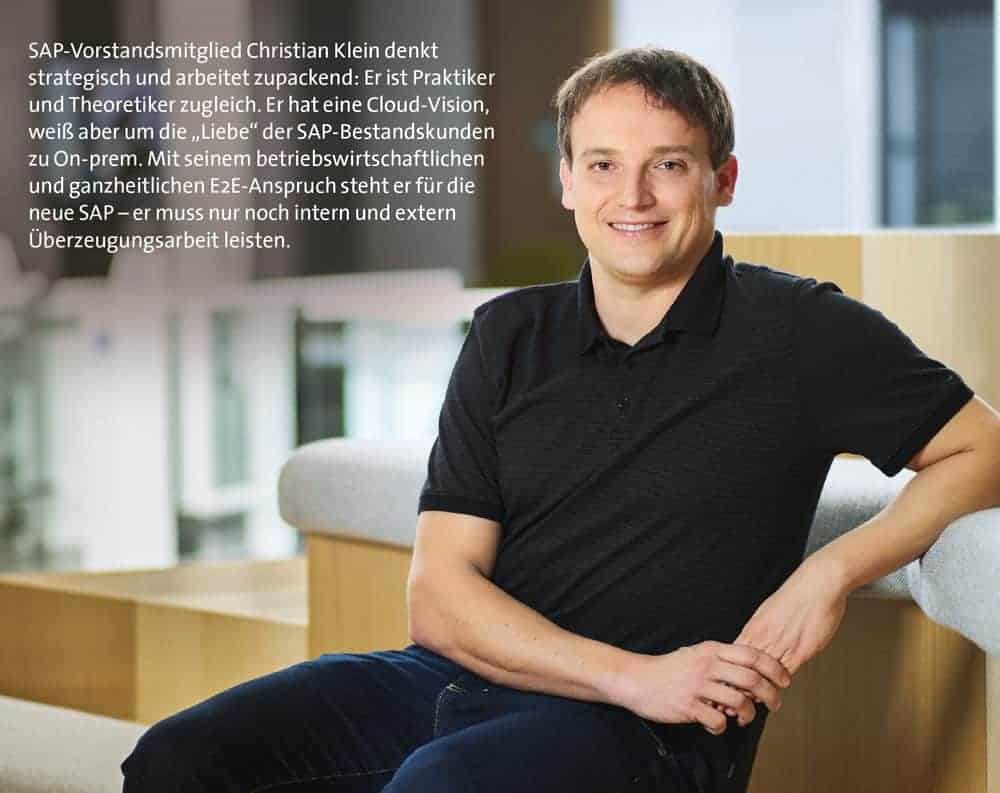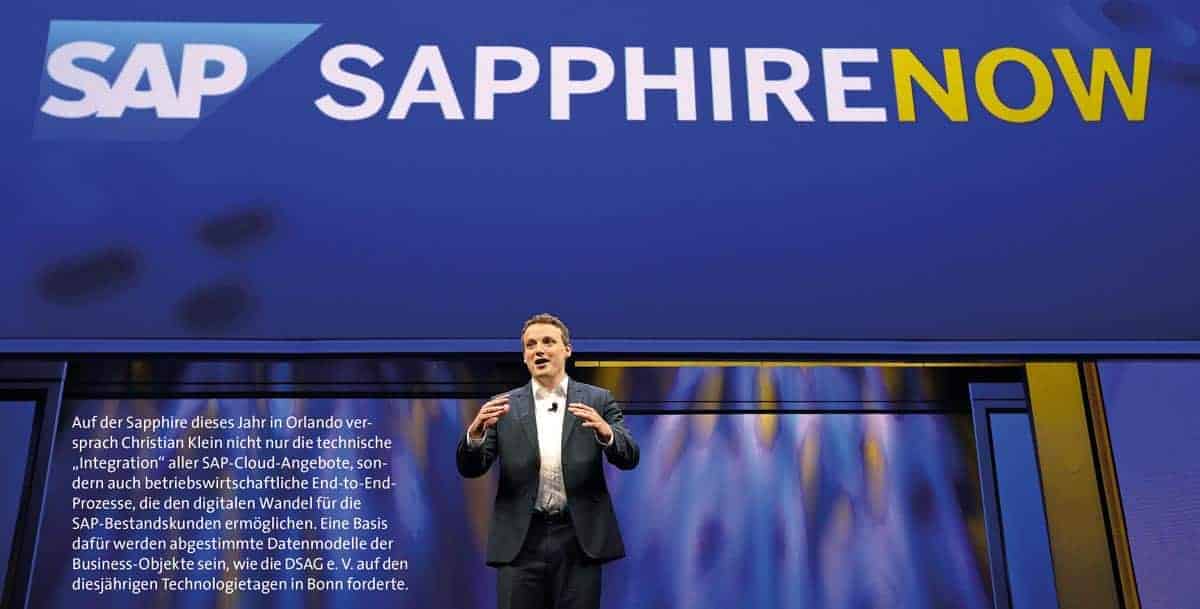Exclusive interview with SAP Executive Board member and COO Christian Klein


SAP is a business and standardized universal system, and CEO Christian Klein is its polymath: In Hanover, he gives German Chancellor Angela Merkel a tour of the SAP trade fair stand, in Walldorf he opens an SAP IoT center with Peter Altmaier, Federal Minister for Economic Affairs and Energy, and "on the side" he takes care of the integration of SAP's cloud acquisitions.
For years, there was a standstill here, and even the DSAG user association complained. Since Klein took on "integration," there has been movement in the cloud, which he is now breathing a new soul into: The technical integration must succeed; however, Klein's focus is on the end-to-end business processes.
The soul of the new cloud is business and organizational added value. E-3 Editor-in-Chief Peter M. Färbinger spoke with COO Christian Klein about this "cloud revolution".
Mr. Klein, where does SAP currently stand?
Christian Klein: Our portfolio has broadened extremely in recent years. As a result, we are now faced with the task of explaining the interrelationships to existing customers and showing how the various products interact in the digital world.
Our focus is very much on transformation in the direction of the cloud. We have already implemented some of this, but there is still a lot to come.
But the transformation is not going as smoothly and quickly as some members of the SAP community would like, is it?
Small: Since the acquisition of SuccessFactors in 2011, we have been gradually transforming SAP into a cloud company. We have already made very great progress in this process.
Questions regarding integration with our ERP solutions are of course justified. But if we had been less consistent in taking the path to the cloud, SAP would not be in such a successful position today.
We have redone a lot of things, but I don't want to claim that we have reached our goal yet. There is certainly a need for further optimization in some areas - including within SAP.
Can you quantify the need for optimization?
Small: The change was important for us in two ways: on the one hand, we are bringing products to the cloud, and on the other hand, we are initiating operational changes.
After all, what does it mean for internal processes when the service no longer takes place on-premise at the customer's premises, but in the cloud? New processes had to be set up here, which was also an expression of the digital transformation at SAP itself.
Where do you see the challenges of this digital transformation?
Small: Well, we have developed on-premise products for years and delivered the corresponding support and service. And suddenly the requirements and the market change.
It is not only a question of technology, but also a cultural change. Openness to new things, the will to map new business processes, is becoming increasingly important. We have to bring people along with us.
My job as COO is to communicate and explain the change. Why do we have to change certain processes, certain workflows, in order to still be successful in the future? I think that is also what moves many customers when they implement SAP S/4 Hana.
So it's a big technical challenge, isn't it?
Small: It's always very important to me not just to talk about the technical side of the digital world. The challenge is also:
What new business models are there in the industry? How do we align processes better? How do we bring them back to standard to act more agile in the future?
The topics of business process integration and artificial intelligence are visibly gaining in importance. For us, it's all about ultimately giving customers a competitive advantage.
I believe that this wall in the minds is almost a bigger challenge than in the end the implementation of S/4 Hana or a cloud solution.
What moves SAP's existing customers in this regard?
Small: Our customers are currently thinking very carefully, for example with the support of design thinking, about how their business will change in the digital world.
These changes on the business side must necessarily be accompanied by changes on the technical side. I notice that with S/4 Hana, customers are taking more time to consider the changes to their business.
I think the SAP community agrees that SAP's direction is right. But for many, the speed seems too slow. And the cloud operating model is not always convincing against the backdrop of decades of on-prem experience. So, cloud or on-prem?
Small: Both and. We continue to see a very high demand for S/4 Hana on-premise among many of our existing customers. That is why we will continue to invest here.
In addition, we are well advised to provide customers with hybrid support. In the future, too, there will be customers who want to run their applications in their own data center.
Why and where?
Small: In industries with high process complexity, such as manufacturing and automotive, where ERP customizations are required, it is not so easy to implement a public cloud solution.
The same applies to companies in countries with political instability, limited infrastructure, or heightened concerns about data security. That's why we believe there will continue to be a very large on-premise market here.
We see the move to the cloud in other areas such as HR, procurement, front office and CRM. Here, we want to support customers to go to the cloud in a modular way in the future, but with a strong integration into the ERP core.
An example?
Small: With SuccessFactors integration, we have provided APIs for technical integration. But our customers want more. Those who run SAP solutions also want business integration.
It's not just about bringing data from a SuccessFactors system into an SAP Hana system. We need a platform that integrates all the components of a business process so that, in the end, both applications speak the same language and intelligent business processes can be mapped in the standard.
And SuccessFactors can do that? The data models are different, aren't they?
Small: For SuccessFactors, we will deliver a harmonized data model in November of this year. The data model will be unified in SuccessFactors and in S/4 Hana and can then be used by both solutions via the SAP Cloud Platform.
In parallel, we are standardizing the workflow service and the user interface. End users will then have an end-to-end business process between S/4 Hana and SuccessFactors. With the November release, many customers will experience this integration.
Does this only apply to SuccessFactors?
Small: We are also planning such a native integration for SAP Analytics Cloud. And a Qualtrics integration will be added in November. Experience Management with S/4 Hana is also scheduled to launch in November.
In order to map new business models as end-to-end processes, the topics of integration and end-to-end operational processes are of elementary importance.
Her presentation at Sapphire as part of Bill McDermott's keynote was very well received. At the same time, however, many existing SAP customers noted that SAP was promising "integration" here for the future, which already exists with R/3 and ECC 6.0. What now?
Small: Undeniably, the end-to-end integration of all business processes and a data model are part of the R/3 success story. Now we have the acquisitions of the past few years with extremely good solutions, but which are not yet perfectly integrated into the SAP core.
I believe we now need to discuss and ensure the consistency of business processes, but at the same time make them more intelligent. It's not just about integration, but also about the topic of innovation.
What do you mean?
Small: In the digital world, procurement works differently than it did ten years ago. Today, artificial intelligence can ensure that the right supplier is always selected. If one fails, the system is supposed to get in touch and offer suggestions for a solution.
The roadmap?
Small: In November, as I mentioned, the SuccessFactors integration will come and next year we will see the same with Ariba. Next year, we will continue to push the envelope on procurement, including front-office integration with C/4 Hana.
Domain model harmonization between Ariba and S/4 Hana has also been ticked off in the meantime. We are synchronizing Ariba and S/4 Hana development in the "Supplier" domain.
We have to get to "one" supplier with all its attributes - analogous to the data model of the customer and the employee. This is quite important, because SAP customers not only want seamless integration, but also a 360-degree view of their own customers.
With this, you are taking up a demand made by DSAG at this year's Technology Days, aren't you?
Small: We will again specify and present even more detailed timelines at the upcoming SAP TechEd. I am driving this topic with very great vigor.
Legitimate questions arise here. For what reason does the use of SAP require custom build integration again? Why do I need further manual effort to match data models?
Two years ago, when I wanted to transfer data to Ariba, it only went through a CSV file, right?
Small: Exactly. Customers today expect an Amazon-style ordering and delivery channel - but that requires perfect integration. This is why customers choose SAP rather than a niche provider that is undoubtedly also good.
In the end, value creation must take place along the process chain, and this is where our strength lies. I remain committed to this topic until the customers say: Now we've got the integration sewn up!
The digital world brings major challenges not only for SAP, but also for the partner community. Small SAP partners fear that they will be left behind. In his comments on the Q2 financial figures, Bill McDermott mentioned Infosys, with which a partner agreement was signed regarding industry solutions. But what is left for the smaller SAP partners?
Small: For partners in particular, the Intelligent Enterprise concept brings very great advantages. Anyone who wants to go to the S/4 Hana cloud version has to go back to the standard. Public Cloud only works in the standard.
But that also means removing Abap modifications. As SAP, we cannot map all 25 industry-specific functions and extensions in the public cloud. For that, we need partners.
We have set up a program to enable even more partners to build specific extensions on our platform. The demand on the market is very high.
Partners are therefore extremely important for us. In the service environment, too, we have nowhere near as many consultants as we need. We will need thousands of consulting firms to cover future demand.
And again on the topic of integration: In the past, the data model was always part of R/3. Now we are putting the data model on the SAP cloud platform.
The partners can now access SAP's master data model directly. This is a huge advantage because it allows integrated solutions to be developed.
But some partners worry about their intellectual property when they bring their solutions to cloud platforms.
Small: I'm happy to talk to the partners about that. We want the partners to build and sell their solutions independently on our platform.
If there are concerns about IP, we have to talk about it. We want to act openly here, because only with a successful partner network can we also be successful.
What to do?
Small: I see a certain need to catch up in partner enabling. That's why we're going to set up a separate department in my area of the Board of Management to help us train partners, particularly in the service area.
But we will also support the partners so that they learn to develop their own applications on our platform. I definitely want to intensify the exchange with the partners because I am convinced that in the end we can only be successful together.
In many customer projects, I see the need to go back to the standard - for this, the know-how of the partners is absolutely essential.
There are many tasks ahead, but SAP has now laid off employees. Why?
Small: Much has already been said about SAP's restructuring. Once again, SAP is growing and by the end of this year we will have over 100,000 employees. A lot has been invested in new applications.
Hana is growing tremendously and is one of our key competitive advantages. We have now consolidated a few sites that came into the company as a result of our dynamic growth. The background to the restructuring was a partial inefficiency.
But we have retained and passed on the know-how of the employees who left us through internal know-how transfer.
Hana 1 or Hana 2? Hana is certainly very successful, but also an eternal construction site, isn't it?
Small: We are confident that we will be able to bring all customers onto Hana 2.0 very soon. We have almost all applications on Hana. SuccessFactors has moved, Ariba too.
For the Ariba network, we still need until the end of this year. We can access Hana natively with our analytics solution. There are no more aggregates and there is no data replication.
So is Hana more construction site or does the database have added value?
Small: 11,500 customers have now opted for S/4 Hana, and we count more than 30,000 customers for SAP Hana. In all discussions with customers, we talk about the added value of S/4 Hana and the digital processes.
I am not aware of any Hana problems in daily operations - on the contrary. We have the broadest offering on the market, precisely because of Hana. Real-time and real-time computing are features that bring a real competitive advantage.
It was Hasso Plattner's greatest innovation; Hana is indispensable for customers' digital business processes. Now we are bringing in-memory technology to the cloud and working to improve TCO. Real-time business control and integration are the added value of SAP for our customers.










